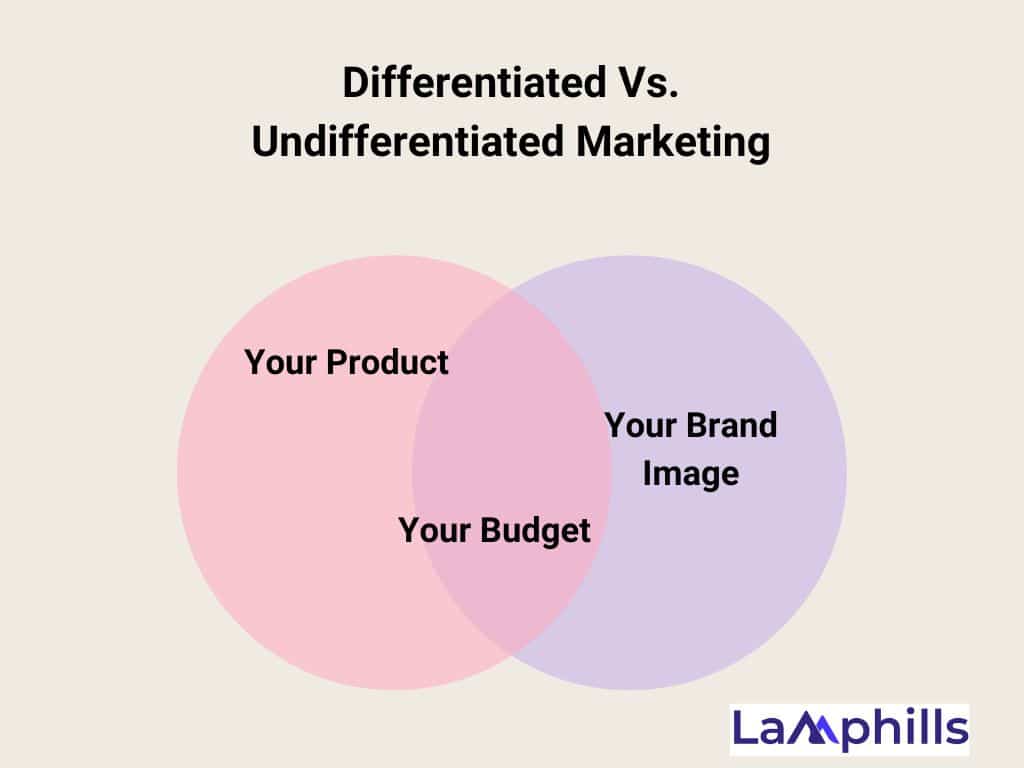Many companies find it hard to stand out in the market. This may be due to how they share their brand story and interact with their customers. Unfortunately, many brands rely on undifferentiated marketing, also called mass marketing.
While this approach has its advantages, it also has some major drawbacks. Undifferentiated marketing treats all customers equally without breaking the market into smaller, unique groups.
This strategy tries to reach as many people as possible with a general message rather than tailoring it to specific groups. While it may seem simpler, it challenges businesses that want to build strong customer connections.
Now, the question is, is undifferentiated marketing right for your business? Keep reading to discover how to overcome the challenges and better connect with your audience.
Key Points
- Undifferentiated marketing allows you to reach a large group of people with a single message, increasing your brand’s visibility quickly.
- Using one broad marketing campaign is more cost-effective than creating multiple targeted campaigns, saving on resources like time and money.
- With just one message to manage, undifferentiated marketing simplifies your overall marketing efforts, making it easier to maintain consistency.
- Delivering the same message across all platforms makes your brand more recognizable, helping to build a strong and consistent identity.
- The biggest challenge is that the message might feel too broad, making it harder to connect with individuals on a personal level, which can affect engagement.
What is Undifferentiated Marketing?
Have you ever wondered how some brands reach millions with just one ad? That’s the magic of undifferentiated marketing. It’s a way for companies to share one message with a large group of people without focusing on specific audiences or custom messages.
From my experience, this simple strategy can be a huge boost for brands wanting to reach more people without complicating their marketing.
Simply put, Undifferentiated or mass marketing is about creating one message and sharing it with everyone. Instead of dividing your audience into segments, you treat everyone equally. Think of it like casting a wide net in the ocean. The goal is to capture the attention of as many people as possible with one clear message.
Big brands like Coca-Cola and McDonald’s have mastered this. They don’t create different ads for different groups of people. Instead, they focus on broad, relatable themes; happiness, togetherness, or enjoying a meal that connects with people of all ages, backgrounds, and lifestyles.
Examples of undifferentiated marketing include:
- Super Bowl commercials: Many companies spend big on Super Bowl ads to reach a wide audience without focusing on specific groups. These ads often use humor or general themes that can appeal to a large number of viewers.
- Billboard advertisements: Billboards are aimed at drivers or people walking by in certain areas without dividing them into different groups. They use simple images or messages to grab attention quickly but don’t offer personalized or relevant content.
- Television infomercials: Infomercials are long commercials that promote products to a general audience. They try to grab attention with demonstrations and convincing sales tactics, but they don’t use personalized messages as more targeted marketing does.
Differentiated Vs. Undifferentiated Marketing

Creating a successful marketing campaign involves making many decisions. The marketer needs to choose not only what message they want to share about the product but also who the message is for. This often means creating different marketing content for each audience group.
Many people today prefer and expect personalized marketing tailored just for them. It helps them build a personal connection with the brands they buy from and keeps them loyal. However, undifferentiated marketing that targets a broad audience can also be effective.
Deciding between a differentiated or undifferentiated marketing strategy for your next campaign depends on which one aligns better with your business goals. Here are a few points to consider when comparing each option’s advantages and disadvantages.
#1. Your Product
One main thing to consider when deciding between differentiated and undifferentiated marketing is the product you’re selling.
Some products are made for a specific group of people. For example, an expensive perfume for women will likely attract a small particular group, so targeted ads would work better for this type of product.
On the other hand, an undifferentiated marketing approach works best for products everyone needs, like toilet paper, bread, or toothpaste.
Undifferentiated marketing helps you reach as many people as possible, while differentiated marketing focuses on a smaller, specific group.
#2. Your Budget
If you have a tight marketing budget, it’s important to get the most value out of every dollar.
Undifferentiated marketing, where you use one campaign for everyone, may seem cheaper at first. However, to be successful, it still needs to bring in enough profit to be worth the cost.
Undifferentiated strategies can offer good value for products that appeal to a wide audience. But if your product is targeted at a specific group, a broad campaign might not connect with the right people. In this case, a more focused marketing approach will give you better results.
#3. Your Brand Image
If your business wants to attract a specific group of people, building a unique brand identity is essential. The goal is to connect your brand and products with what your customers care about, the lifestyle they want, or a sense of belonging to a group.
This type of marketing often uses specific images and messages that match those goals.
On the other hand, if your business wants to reach a wide audience, make sure no one feels left out. Undifferentiated marketing works well for this. Consider campaigns highlighting things everyone cares about, like good prices, convenience, and availability.
Remember: You don’t have to stick to just one of these strategies forever. Many businesses start with one and switch to the other as their marketing goals change.
If you’re still not sure if undifferentiated marketing is right for your business? Don’t worry! Our Marketing Strategy Checklist can help you decide. This simple guide will walk you through key questions to see if this broad approach fits your product and goals.
Take a look and find out if undifferentiated marketing is the right strategy for you!
Now, let’s take a look at some of the benefits of mass marketing.
Benefits of Undifferentiated Marketing
I once worked with a drink company that decided to change its marketing plan. Instead of focusing on a specific group, they wanted to reach as many people as possible to grow their brand and get noticed by more people. At first, I wasn’t sure if it would work because I was used to creating special messages for different types of customers.
But as the campaign continued, I saw the power of this new approach. The company shared a simple, positive message that everyone could relate to, regardless of age or background. Their reach grew quickly in just a few weeks, and sales went up because the message was for everyone.
This experience taught me how broad marketing can help a brand get recognized and grow fast.
Here are some benefits of undifferentiated marketing:
#1. Wider Audience Reach
One key benefit of undifferentiated marketing is that it allows your brand to reach a broad audience. You’re not limiting yourself to a specific group, so your message has the potential to resonate with a larger pool of people. This is great for brands that want to increase their visibility quickly.
#2. Cost Efficiency
Creating one marketing campaign for everyone is cheaper than making different ones for different groups. You save on research, creativity, and targeting, allowing you to use your resources more wisely.
#3. Simplified Marketing Strategy
With undifferentiated marketing, you don’t have to juggle various campaigns targeting different audiences. There’s just one message to push across all channels, making it easier to manage. This simplicity can streamline marketing operations and reduce complexity, which is something I’ve come to appreciate after dealing with complex, multi-segmented campaigns.
#4. Brand Consistency
Undifferentiated marketing helps maintain a consistent brand message. When your marketing is aimed at everyone, you ensure that your core message remains the same, no matter where it’s being delivered. This builds brand recognition and fosters a strong identity, which is crucial for long-term success.
Challenges of Undifferentiated Marketing

However, undifferentiated marketing has its drawbacks. Because the message is broad and not aimed at specific groups, it may not connect well with individual customers. This can lead to fewer sales compared to a more targeted marketing approach.
Also, by not focusing on specific groups, businesses might miss the chance to meet different customers’ unique needs and preferences, which could result in losing potential sales and customer loyalty.
#1. The risk of being too generic
One challenge with undifferentiated marketing is that it can sometimes feel too generic. While it’s great to appeal to the masses, there’s always a risk that the message won’t resonate deeply with anyone. Some people may feel like the brand doesn’t speak directly to their needs or interests, leading to disengagement.
#2. Miss out on niche markets
Another downside of this approach is that you could miss out on niche markets. If you focus solely on appealing to everyone, you might overlook opportunities to connect with specific groups that could have been more loyal customers. I saw this happen in one project when we tried to go broad with a fashion brand. We lost some core niche audiences because the messaging was too general.
#3. Face intense competition
Since undifferentiated marketing casts a wide net, it means you’re competing with many other brands for the same audience. It can be harder to stand out because you’re not targeting a specific group. It takes a compelling and creative campaign to break through the noise when using this approach.
Strategies to overcome undifferentiated marketing challenges
To solve the problems that come with undifferentiated marketing, businesses need to build a stronger connection with their target audience. By using specific approaches like market segmentation, creating a unique value, and running personalized marketing campaigns, businesses can adjust their strategies to stand out and achieve better results.
#1. Market segmentation
Market research is a key part of any business. It helps you figure out if your product is a good match for your target audience. It also shows you the best ways to share your brand message with customers.
Through research, you may discover that your customers fall into different groups. By breaking the market into these smaller groups, you can learn what each one likes, needs, and prefers.
This helps you tailor your marketing efforts to each group, making your messages more appealing and effective. A targeted approach leads to more engagement and higher conversion rates.
#2. Creating a Unique Value Proposition (UVP)
A unique value proposition explains why your product or service is valuable. Whether your business targets a specific group or the general public, having a strong UVP can help you stand out from competitors.
After crafting your UVP, you can share it with your audience through different marketing methods. Many companies use personalized emails, targeted ads, and custom product suggestions to create more meaningful connections, which helps build customer loyalty and increase engagement.
If you don’t know how to explain why your product is better than others, don’t worry; our Unique Value Proposition (UVP) Worksheet is here to help! This easy-to-use guide will help you clearly show what makes your product special and why customers should choose you.
By following simple steps, you’ll be able to create a powerful message that connects with your audience. Start crafting your UVP today using this worksheet!
#3. Personalized Marketing Campaigns
Data analytics help businesses understand how customers behave, what they like, and how they interact. With these insights, companies can create marketing campaigns that match customers’ interests better.
Personalized marketing campaigns offer tailored experiences that meet each customer’s unique needs. Through personalized emails, targeted ads, or product suggestions, businesses can create meaningful connections that boost customer engagement and loyalty.
#4. Competitive analysis
Competitive analysis involves examining other businesses’ activities, such as their marketing, products, and services, to identify their strengths and weaknesses. This helps a business identify areas for improvement.
A business can find areas where customers’ needs aren’t fully met by studying competitors. By filling those gaps and offering something unique, the business can set itself apart and attract customers who want something different from what’s already available.
#5. Innovation and product development
Innovation and product development help businesses stay competitive. By constantly improving their products and services to meet changing customer needs and preferences, businesses can stay relevant for a long time.
In addition to improving what they already offer, businesses can stand out by creating new products or services that solve unmet needs or provide special features and benefits.
By being ahead of the game and creating new solutions, businesses can become industry leaders and attract customers who want fresh and innovative ways to solve their problems.
Top Examples of Undifferentiated Marketing

Image by Wolt
Big companies that make everyday products usually try to reach a wide audience using undifferentiated marketing. The goal is to connect with as many people as possible and become a well-known name.
Here are some brands that have done this successfully.
#1. McDonald’s
McDonald’s offers its food to everyone without focusing on one specific group. Whether you are young or old, male or female, rich or not, McDonald’s advertises the same menu to all people.
They focus on things everyone cares about, like fast service, affordable prices, and tasty food. For example, their ads promote their Big Mac or fries to everyone, showing that their food is for anyone, anytime, anywhere. This broad approach helps them reach a wide audience.
#2. Colgate
When you think of toothpaste, Colgate is probably one of the first brands that comes to mind.
Like many brands that aim to reach a broad audience, Colgate’s main product—its toothpaste—is designed for everyone, not just one specific group.
Their marketing usually highlights the toothpaste’s effectiveness, affordability, and other benefits that appeal to a wide range of potential customers.
#3. Coca-Cola
When asked to name a well-known brand, most people would immediately think of Coca-Cola. Since its founding in 1893, Coke has worked hard to make its famous soft drink popular worldwide. It does this by linking its brand and products with ideas like family, friendship, and tradition.
#4. General Motors
Undifferentiated marketing works well for promoting expensive products, like cars and trucks, and General Motors does it really well.
GM’s brand strategy is focused on building safe, reliable vehicles that suit everyone. Their ads often highlight how their range of products can fit any lifestyle or budget.
Is Undifferentiated Marketing Right for Your Business?
Undifferentiated marketing works best for businesses that sell products or services everyone can use. If your product appeals to a wide range of people, such as food, drinks, or everyday items (like soap or toothpaste), this approach can help you reach more people with one simple message.
For example, if you sell a product like bottled water, you don’t need to create separate ads for different groups of people. Almost everyone needs water, so one message can work for everyone. This makes undifferentiated marketing a good fit for your business.
However, if your product is meant for a specific group, like high-tech gadgets for professionals or toys for children, undifferentiated marketing might not work as well. In this case, you might want to use a more targeted approach to connect better with your specific audience.
In short, if your business offers something everyone can enjoy, undifferentiated marketing can help you grow. But it’s worth considering other strategies to reach the right people if you have a niche product or service.
Final Thoughts
While undifferentiated marketing offers excellent benefits, like reaching a wider audience and saving on costs, it also comes with challenges. It’s important to ensure your message is clear and engaging to overcome these. Even though you’re targeting everyone, your message shouldn’t feel too generic; make it relatable and meaningful.
You can also stand out by being creative. A strong, memorable campaign in a crowded market can help you rise above the competition. Pay attention to what works and adjust your strategy if needed.
Lastly, stay open to feedback. If you notice that your audience isn’t connecting with your message, don’t hesitate to tweak your approach. By addressing these challenges thoughtfully, you can make undifferentiated marketing work for your brand and maximize its impact.
Answers to FAQs
Why would a company use an undifferentiated marketing strategy?
Wider reach: The aim is to connect with as many people as possible. This type of marketing helps attract a large audience, which boosts brand awareness, recognition, and overall appeal.
How does Coca-Cola use undifferentiated marketing?
Coca-Cola campaigns target large groups of people with the same message. They don’t change their marketing or messaging for different groups and usually keep the same distribution methods to reach as many people as possible.
What does undifferentiated mean in marketing?
Undifferentiated marketing is a strategy in which the same message is used for all customers instead of tailoring it to different groups. This approach targets everyone as a whole rather than focusing on specific audiences. It’s also known as mass marketing.
Does Apple use undifferentiated marketing?
No, Apple uses a differentiated marketing strategy. This means they make their products stand out by focusing on design and adding new features over time. The main advantage of this approach is that it helps build a loyal customer base and makes it harder for competitors to beat them.
What are the issues with undifferentiated marketing?
Undifferentiated marketing problems include not having focused messaging, finding it hard to stand out from competitors, and lower customer engagement and loyalty.
Similar Articles
The Essentials of Effective Integrated Marketing Campaign + Templates
A Detailed Guide to Effective Marketing Strategies for the Gaming Industry
Real-Time Marketing Campaigns: Best Practices and Examples for Instant Success






